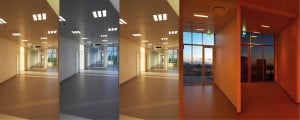The field of lighting technology is advancing at a rapid pace, with the latest breakthrough being lighting systems that are designed to support the body's natural circadian rhythm. But how do you navigate the various types of lighting and determine which one is best for your needs? In this article, we will explore the various categories of lighting and provide guidance on when to choose each one.
According to lighting expert and civil engineer Torben Skov Hansen, the key to the right lighting lies in understanding the specific needs. Torben Skov Hansen, who is the Chief of Technology at Chromaviso, explains that finding the perfect lighting solution requires considering individual requirements.
Research is currently underway at Aarhus University Hospital and Rigshospitalet Glostrup to study the effects of the new circadian lighting on patients and staff. The results of patient measurements at Aarhus University Hospital and Rigshospitalet Glostrup will be available in 2016.
— We hope to document some trends regarding the effects of light on circadian rhythm, sleep, and well-being,
Leanne Langhorn, a Clinical Nurse Specialist and Ph.D. at Aarhus University Hospital.
Lighting for a 24/7 cycle
But when should you choose circadian lighting? Torben Skov Hansen offers his insight:
— Circadian lighting is ideal for areas that are staffed around the clock, 24/7. The lighting changes throughout the day, mimicking natural light patterns, with the brightest light in the middle of the day. At night, the lighting transforms into a special night light that doesn't disrupt the body's circadian rhythm. This helps both staff and patients achieve better sleep, well-being, and behaviour.
Circadian lighting includes a night light that is specially designed to support the body's circadian rhythm while also ensuring good lighting conditions for the working staff. It is based on a clinically validated lighting protocol that requires selected fixtures capable of providing a broad spectrum of light throughout the day.
— Commonly referred to as blue-free light, circadian lighting is actually a unique combination of all other colours that is key to optimal nighttime lighting for both the body and eyes, explains Torben Skov Hansen.

In addition to its physiological impact, circadian lighting also offers ergonomic lighting settings for specific areas and activities.
— Some activities or situations require different lighting than automatic circadian lighting. This could include a spotlight by the patient's bedside, warm lighting for conversations, clear lighting for medication preparation, or bright lighting for emergency situations. It should be easy and intuitive to operate – for both patients, their families, and staff, he emphasizes.
Dynamic lighting for areas staffed during the day
Dynamic lighting is a more simplistic lighting solution often referred to as daylight simulation, tunable white, or kelvin change. It is characterized by its ability to vary in colour temperature and intensity.
In areas where daylight hours are the only active period, dynamic lighting with daylight simulation is an excellent choice. It is crucial to have sufficient light that automatically changes throughout the day, explains Torben Skov Hansen. Additionally, the white light can be supplemented with RGB-coloured light to create a specific ambience.
— Daylight simulation supports both the body's circadian rhythm and well-being while providing visually pleasing light. On the other hand, RGB-coloured light solely focuses on the visual aspect, he explains, highlighting that white light should not be used at night as it negatively affects the health of both patients and staff.
Static lighting meets basic lighting needs
Despite the increasing popularity of the new lighting categories in the healthcare sector, there is still a need for static lighting. This basic solution consists of either white or coloured light and can include a dimming function.
— Static lighting covers simple lighting needs, such as in rooms where people spend shorter periods of time. With a dimmable solution, you have the ability to adjust the brightness to the varying lighting needs of the room while also reducing the harshness of the white light, concludes Torben Skov Hansen.

